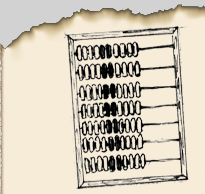


|
At the beginning of the 19th century Calculating on the Lines method was already forgotten in Western Europe, but available mechanical calculation machines were still not invented. In fact, stchoty were then the only calculation instrument and so they were really of great value. Though, stchoty were practically unknown in other countries. Europe learned about stchoty from Jean-Victor Poncelet. While being in Russian captivity, Poncelet got acquainted with stchoty and appreciated them highly. In September 1814, when he was returning from Russia, he brought stchoty to France with him. Soon Poncelet embedded stchoty in educational process of some Metz schools, where he served. By the beginning of 1840s stchoty became very popular in most French schools, where they got the name boulier. In 1860s stchoty were spread in Germany, and many other countries including England. Undoubtedly, European and American authors of numerous patents often were inspired by the Russian stchoty construction. Also Russian inventors patented their inventions abroad: F. Ezersky, A. Monachimoff and others.
Even in the second part of the 20th century industry of different European countries continued to produce calculation devices totally identical to Russian stchoty. For example, German company "Ernst Paul Lehmann Patentwerk" produced stchoty with "Primus" brand.
Russian stchoty were well-known in neighbouring to Russia countries. For example, Christo Botev introduced stchoty in Bulgaria. In 1863-66 Botev lived and studied in Russia. And there he got acquainted with stchoty. In 1873 he translated one of the Russian arithmetic textbooks into Bulgarian language. In this textbook all practical tasks were explained with help of stchoty. Christo Botev upgraded Russian stchoty construction. He adapted stchoty to Bulgarian financial system. Not only the idea of stchoty but their name were borrowed in Iran. Iranian dictionaries define “stchoty” (chotken) as the word of the Russian origin. Another examples can be given. But anyway the examples mentioned above affirm that opposite to swan pan or soroban Russian stchoty didn't remain the national phenomenon only, but won international recognition. They were borrowed and have been used widely in different countries for more than 100 years. Russian stchoty gave also powerful impulse to inventors around the world. |





